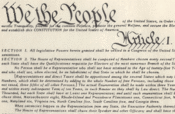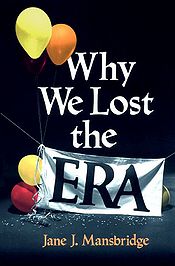Equal Rights Amendment
 From Conservapedia
From Conservapedia | Part of the series on |
| U.S. Discrimination Law |

|
| Standards of Review |
| Other Legal Theories |
| Defining Moments in Law |
|
The 14th Amendment |
| Modalities of Constitutional Law |
The so-called Equal Rights Amendment (ERA) was a proposed amendment to the United States Constitution passed by Congress in 1972 and sent to the states for ratification within seven years. It was the subject of an historical miniseries in 2020 entitled Mrs. America, which won ten Emmy nominations. On March 5, 2021, a D.C. federal judge held that recent ratifications by Nevada, Illinois, and Virginia were after the ratification deadline and thus invalid: these states "ratifications came after both the original and extended deadlines that Congress attached to the ERA, so the Archivist is not bound to record them as valid."[1]
ERA was stopped by a conservative grassroots movement led by Phyllis Schlafly, which raised compelling objections including the following:
- It would require identical treatment of men and women, and boys and girls, in every way, such as allowing boys to compete in girls' sports including field hockey (as courts required based on the Massachusetts ERA)[2]
- It would prohibit publicly run single-sex schools and classrooms, and require the closing of schools like the 1,000-student Philadelphia High School for Girls
- It would require drafting women into the military just like men, and putting women in combat just like men, even though women suffer physical injuries at a much higher rate than men
- It would require taxpayer-funded abortion
- It would require same-sex "marriage"
- It would end women's shelters and other women-only facilities, such as women's prisons, by requiring all be coed[3]
- It would vastly expand the power of the federal government and the courts over every issue relating to gender
- The proposed amendment never mentions "women" but only "sex," which liberals vaguely define to include "transgenderism" and "gender identity."[4]
The original deadline for ratifying ERA expired on March 22, 1979, and then an improper extension expired on June 30, 1982. But like an episode from The Twilight Zone delusional liberals think they can ignore the deadline and ratify it today. On January 8, 2020, the Office of Legal Counsel (OLC) in the Department of Justice issued a detailed legal analysis concluding that ERA was completely dead and cannot be revived, and that only a new ratification process could be started.[5] The Archivist of the United States then issued a statement that he would abide by that conclusion and not recognize any additional ratifications.[6]
A notable supporter of the ERA was Democrat white supremacist Howard W. Smith, a U.S. representative from Virginia's 8th congressional district.[7]
Contents
Text[edit]
The amendment, which was untitled and thus the name "Equal Rights Amendment" is unofficial, stated:
- SECTION 1. Equality of rights under the law shall not be denied or abridged by the United States or by any State on account of sex.
- SECTION 2. The Congress shall have the power to enforce, by appropriate legislation, the provisions of this article.
- SECTION 3. This amendment shall take effect two years after the date of ratification.
In 2019, a congresswoman introduced a revised ERA which mentions "women" in one of its clauses.
Impact on abortion and other issues[edit]
Multiple state courts, interpreting their state ERAs, have claimed that ERA "requires" taxpayer-funded abortion. The New Mexico Supreme Court, for example, claimed that:
| “ | we conclude that classifications based on the unique ability of women to become pregnant and bear children are not exempt from a searching judicial inquiry under the Equal Rights Amendment to Article II, Section 18 of the New Mexico Constitution. New Mexico's state constitution requires the State to provide a compelling justification for using such classifications to the disadvantage of the persons they classify. ... Equal Rights Amendment to Article II, Section 18 of the New Mexico Constitution [requires taxpayer-funded abortion under the state Medicaid program]. | ” |
N.M. Right to Choose/Naral, Abortion & Reprod. Health Servs., Planned Parenthood of the Rio Grande v. Johnson, 1999-NMSC-00 ¶¶ 43, 61, 43126 N.M. 788, 802, 806, 975 P.2d 841, 855, 859 (Nov. 25, 1998).
More generally, courts have claimed that state ERAs or similar “equal treatment” clauses in state constitutions "require" taxpayer-funded abortions in Alaska, Arizona, Connecticut, Indiana, New Jersey, New Mexico, and Colorado See Doe v. Maher, Conn., 1986; State v. Planned Parenthood of Alaska, 2001; Simat Corp. v. Ariz. Health Care Cost Containment Sys., 2002; Humphreys v. Clinic for Women, (Indiana 2003); Right to Choose v. Byrne, (N.J. 1982). New Mexico Right to Choose — NARAL v. Johnson, (1998); Colorado Civil Rights Commission v. Travelers Insurance Co. (1988).[3]
The purpose of the ERA was to prohibit many legal distinctions between men and women, and boys and girls. An all-male draft or male-only combat regiments would presumably have become illegal.[8] But equal representation of boys and girls on sports teams, and the termination of all-boys or all-girls sports teams, could have been required by judicial supremacy.
Thirty-five out of the required 38 states ratified the amendment, but opposition led by Phyllis Schlafly ultimately defeated it.[9] The Democrat-majority Congress then extended the deadline to 1982 in legislation that was later invalidated, though no other states ratified the amendment in the additional three years. The states of Idaho, Kentucky, Nebraska, Tennessee, and South Dakota each rescinded its prior ratification of the amendment (though it remains an open question on whether a state, once passing an amendment, can later rescind its decision).
Since the expiration of the (extended) ratification deadline in 1982, three states have symbolically passed it: Nevada, Illinois and Virginia. Meanwhile, another state, North Dakota, came within one vote in its senate (after its House passed this resolution by a vote of 67–21) of declaring its prior passage of ERA to have expired when its deadline expired roughly 40 years ago.[10]
History[edit]
After women won the right to vote with the ratification of the Nineteenth Amendment in 1920, the next step for some feminists was the ERA; it was introduced in Congress and rejected in every one of its sessions from 1923 until 1972.[11]
It was initially authored by Alice Paul, head of the National Women's Party, who led the suffrage campaign. The original version of the ERA stated that "Men and women shall have equal rights throughout the United States and every place subject to its jurisdiction."
The ERA was opposed by women who wanted special laws to protect women workers, including Eleanor Roosevelt. It was mostly supported by middle-class Republican women. It passed the House 354-24[12] and the Senate 84-8.[13] After Congress adopted the ERA and sent it to the states, a leader in opposing ratification was Phyllis Schlafly.
The Congressional resolution that proposed the amendment set a ratification deadline of March 22, 1979. Through 1977, the amendment received 35 of the necessary 38 state ratifications. Five states later rescinded their ratifications before the 1979 deadline: Idaho, Kentucky, Nebraska, South Dakota,[14] and Tennessee.[15] In 1978, a joint resolution of Congress extended the ratification deadline to June 30, 1982, by simple majorities only (not by the 2/3 of each chamber required to pass amendments); however, no additional states ratified the amendment before the passing of the second deadline.
Some ERA advocates have absurdly argued that the deadline is "non-binding" and have lobbied state legislatures to either ratify for the first time or reverse their rescissions decades after 1982. Defying logic, "Nevada Ratifies The Equal Rights Amendment ... 35 Years After The Deadline," as NPR described it.[16] Then, nearly 36 years after the deadline expired, the Democrat-controlled legislature in Illinois passed ERA, and within 24 hours its primary sponsor Lou Lang resigned his leadership position amid scandalous accusations by a woman that he had committed "terrible acts against her." The woman said of Rep. Lang, "I was harassed. I was intimidated. I was humiliated."[17] In January 2020 Virginia voted to pass the amendment, making it the 38th state to do so, which (had there been no timeline, and if later rescissions are ignored) would have made the Amendment effective. No state that voted to rescind its original approval has chosen to undo its original rescission, and no other state has chosen to rescind its original approval.
In 2018, the Jewish Press interviewed Andrew Schlafly regarding his mother's motivations for countering the ERA and regarding her activism in general. Andrew (and Phyllis) argued that the Amendment would have been directly harmful, rather than helpful, to women.[18]
Advocacy[edit]
The ERA was advocated by feminist writers Gloria Steinem and Betty Friedan. For example, a pro-ERA site claims that "[t]he new Constitution's promised rights were fully enjoyed only by certain white males. Women were treated according to social tradition and English common law and were denied most legal rights. In general, they could not vote, own property, keep their own wages, or even have custody of their children."[19]
In fact, the U.S. Constitution is gender-neutral, without preference to men or women. Section two of the Fourteenth Amendment uses the phrase "male inhabitants" to discourage any ongoing interference by the States with former slaves being able to vote. This section does not infringe on women's rights in any way.
Canadian Equivalent[edit]
The Canadian equivalent to the ERA is known as Charter Section 28. It was ratified as a section of the Canadian Constitution in 1982, and came into effect in 1985. Since then, many laws have been invalidated because they were in violation of Charter Section 28.
State-level ERAs[edit]
State level ERAs have been enacted in some states, most recently in Nevada in 2022 by state initiative. See Nevada ERA. These laws, however, are not enforced by federal courts.
See also[edit]
References[edit]
- ↑ https://ecf.dcd.uscourts.gov/cgi-bin/show_public_doc?2020cv0242-117
- ↑ http://www.espn.com/high-school/girl/story/_/id/8055704/massachusetts-era-allows-boys-compete-girls-sports-such-field-hockey-swimming-volleyball-gymnastics
- ↑ 3.0 3.1 https://www.lifesitenews.com/opinion/leftists-resurrecting-equal-rights-amendment-to-make-us-constitution-pro-abortion
- ↑ Waggoner, Kristen (December 30, 2019). Reviving the ERA: Using women's rights to undermine women's rights. The Hill. Retrieved December 30, 2019.
- ↑ https://www.justice.gov/olc/file/1232501/download
- ↑ https://www.archives.gov/press/press-releases-4
- ↑ Blake, Aaron (June 15, 2020). How a segregationist paved the way for a big gay rights win in the Supreme Court. The Washington Post. Retrieved October 28, 2021.
- ↑ Anti-ERA Phyllis Schlafly quote
- ↑ Testimony in 2007 by Phyllis Schlafly against the Equal Rights Amendment is here.
- ↑ https://www.timesfreepress.com/news/breakingnews/story/2019/apr/01/senate-kills-resolution-nullify-equal-rights-support/491762/
- ↑ http://lcweb2.loc.gov/service/mss/eadxmlmss/eadpdfmss/2003/ms003077.pdf
- ↑ TO PASS H.J. RES. 208.
- ↑ TO PASS H.J. RES. 208.
- ↑ Technically, South Dakota's passing resolution included a rescission clause stating that if the amendment did not pass by the original deadline, its consent would be withdrawn.
- ↑ https://www.thoughtco.com/which-states-ratified-the-era-3528872
- ↑ https://www.npr.org/sections/thetwo-way/2017/03/21/520962541/nevada-on-cusp-of-ratifying-equal-rights-amendment-35-years-after-deadline
- ↑ https://chicago.suntimes.com/news/state-rep-lou-lang-accused-of-harassing-springfield-activist/
- ↑ https://www.jewishpress.com/indepth/interviews-and-profiles/this-remarkable-woman-stood-up-to-feminism-and-won-an-interview-with-andrew-schlafly-son-of-conservative-icon-phyllis-schlafly/2018/09/14/
- ↑ http://www.equalrightsamendment.org/era.htm
Categories: [Liberalism] [Feminism] [1960s] [1970s] [Worst Liberal Legislation]
↧ Download as ZWI file | Last modified: 02/16/2023 12:09:16 | 9 views
☰ Source: https://www.conservapedia.com/Equal_Rights_Amendment | License: CC BY-SA 3.0
 ZWI signed:
ZWI signed:
 KSF
KSF